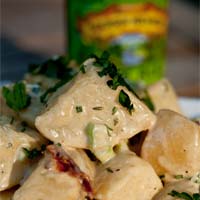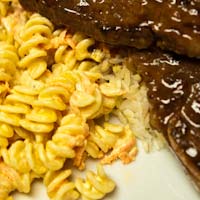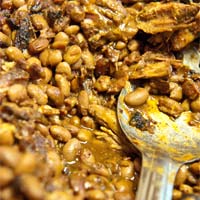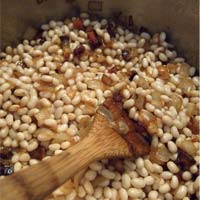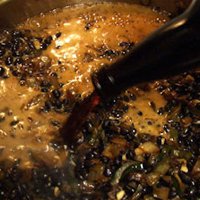Blind Pig-Injected Smoked Pork Butt
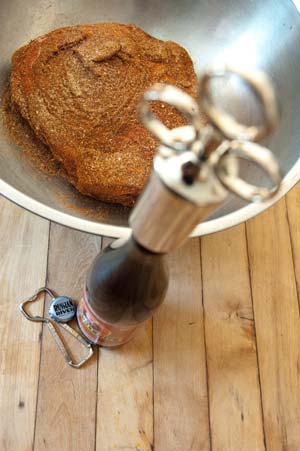 Pulled pork is a beautiful thing. When done right, the swine falls apart at the touch, a great “bark” is formed from the low and slow cooking, caramelizing the rub ‘seasoning’, followed by a deep-pink smoke ring. Improving on this pulled pork idea, most recipes use apple cider or apple cider vinegar. why not add beer and to it to infuse into the pork muscle? Injecting the pork with beer adds more than seasoning into the meat, beer tenderizes it, creates moisture, and added flavor! This Russian River Brewing Co. Blind Pig-Injected Smoked Pork Butt recipe takes BBQ pork to a whole other direction and level. By using a stainless steel injection needle with a great IPA, the flavors of hops and malt are infused deep into the sweet pork meat.
Pulled pork is a beautiful thing. When done right, the swine falls apart at the touch, a great “bark” is formed from the low and slow cooking, caramelizing the rub ‘seasoning’, followed by a deep-pink smoke ring. Improving on this pulled pork idea, most recipes use apple cider or apple cider vinegar. why not add beer and to it to infuse into the pork muscle? Injecting the pork with beer adds more than seasoning into the meat, beer tenderizes it, creates moisture, and added flavor! This Russian River Brewing Co. Blind Pig-Injected Smoked Pork Butt recipe takes BBQ pork to a whole other direction and level. By using a stainless steel injection needle with a great IPA, the flavors of hops and malt are infused deep into the sweet pork meat.
What type of Pork to Buy:
When getting your meat, buying a pork butt | shoulder with the bone is a great tip for better BBQ. The bone works in your advantage when BBQing. One, leaving the bone is easy, not requiring any more fancy knife work from you or the butcher. Two, it’s cheaper than buying a pork butt | shoulder with it removed; less labor involved. Three, the bone pulls the heat into the center of the meat’s muscle, acting as a heated wick. As the muscle tissue and sinuous tissue, IE collagen in the form of tendons, connects to the bone, that bone warms up differently than the surrounding muscle groups. Cooking the pork with the bone-in also improves the flavor, as when cooking any meat with a bone vs the boneless counterpart. Another reason to leave the bone-in is it will help you know when the pork is fully cooked by touch and not just temperature. By grabbing the bone, if it moves easily to the touch, it means the collagen has melted, around 205°F | 96°C internally. This is another way to make sure your BBQ pork is done to the right temperature, bring melt in your mouth delicious, and not over or undercooked.
What is the difference between a Pork Butt and Pork Shoulder cut?
What’s in a name when it comes to a cut of meat is important. What you might think is one thing, is actually another. When looking at the anatomy of a pig, the “pork butt” is actually located behind the neck, not the rear of the pig. Yes, that is correct, the pork butt is not the gluteus maximus of the pig. Pork butt is sometimes called a Boston Butt, depending on where you live. And to make it more confusing, a “pork shoulder” isn’t the shoulder either, this cut is actually below the butt, above the foreleg. Why these definitions and names were labeled this way, I do not know. I just want to help you understand what you are buying and why it matters.
Both pork butt | shoulder have many things in common. Both cuts of the pig are marbled with intramuscular fat, the butt having more of it than the shoulder. This fat to meat ratio is important, as the meat cooks, the fat melts, making the meat tender and full of flavor. Yes, the saying is true, “fat = flavor”. Yet, when it comes to cooking these meat cuts, they both benefit from the low and slow method of cooking, meaning a longer cooking time and a lower cooking temperature. In other words, these pork cuts don’t make a good steak. Leave that to a pork chop or the loin section of the pig.
The pork butt is usually preferred over the shoulder, as the shape of the butt is move uniform in size and shape. The butt is more rectangular, with a more even thickness from one side to the opposite. The shoulder is more triangular, with a tapered side that will cook faster than the thicker, wider end.
Both the pork butt | shoulder are sold with or without the skin. I usually prefer a skinless cut for this beer injected smoked pork butt recipe. As the crispy skin isn’t the goal of this recipe and the BBQ rub doesn’t stick to the skin as well as the meat muscle, skinless makes more cooking sense.
To learn more about the different cuts of a pig, check out this page.
Cooking with IPA | Cooking with Beer:
When cooking with beer, especially cooking with an IPA | APA | DIPA, it is important to understand more about the beer style and its hop character. This beer injection cooking technique preserves why we like to drink IPA’s (India Pale Ale). The hop flavor is not cooked over an intense flame, but rather a gentle indirect heat, therefore it doesn’t reduce the brew. Reducing the beer, especially an APA | IPA | DIPA over direct heat consequently increases the bitterness, driving off all the aromatic and flavor elements of the hop when it is boiling. The brewer and brewery work very hard to add hop flavors to a beer through multiple hop additions when brewing the beer style, whirlpool hopping, and wet hopping during the fermentation process. When heat is added to beer, in the form of direct heat, the evaporation process removes the water, increasing the hop oils, while boiling off much of the flavor and aroma characteristics that make APA | IPA | DIPA so special to drink. Injecting beer into this pork butt removes much of the possibility of cooking the beer, which in turn preserves the hop ratio to beer liquid and doesn’t make the final product inedible. If you’ve ever had an IPA reduction, you’ll understand what I am talking about. This is a key fundamental Beer Cuisine cooking technique to understand, especially when cooking with ale and hoppy beer styles.
Why Inject Beer into the BBQ Pork Meat:
Beer Brining is one way to ensure a well seasoned, flavorful, and moist meal. With larger cuts of meat, this cooking technique works wonders on pork, turkey, and chicken. My Beer Brined Turkey has won people over, each Thanksgiving, year after year. This is a similar approach, as beer is injected straight into the muscle vs it marinating in a bath of beer, water, salt, and sugar. In this recipe, I take the beer, garlic and BBQ rub, mixing them together, to add more flavor to the inside of the meat. As the pork butt is thicker, it will take many days to fully brine the butt. Using a needle attached to a reservoir of marinade helps get the flavor deep into the muscle tissue. Injecting verses beer brining also takes less time to have it ready to cook.
When injecting the pork butt | shoulder with beer, or any marinade, it’s best to put a few holes in the meat as possible. The muscle is not a pincushion. More is not better when it comes to injecting your meat. More holes mean more ways for the beer marinade to exit the muscle. Buy a good meat injector. Plan each entry point before you inject the meat.
Below I recommend a meat syringe that is stainless steel and comes with three different needles, for different injection applications. All the needles will puncture the muscle, it comes down to how best to distribute the beer marinade into the meat. For this Blind Pig-Injected Smoked Pork Butt, I suggest using the needle with holes on all sides, to get the most bang for the buck, with each hole created, getting the beer into as much of the muscle as possible. This does create another problem. More holes mean more possibility to clog the holes with the garlic and spices. Mincing the garlic will help, puréeing the garlic and spice rub with the beer is better. Place the marinade into a container, IE a mason jar overnight, then straining it through a fine sieve or cheesecloth will ensure a clog-free beer injection experience.
When injecting, go deep. Planning your entry point and how deep the needle will go. Shoot for the thickest part of the muscle or muscle groups. Start squeezing the beer marinade into the meat, slowly pulling the syringe out, applying equal pressure to the syringe the whole time, using all or most of the marinade in the syringe before the top holes of the needle exit the meat.
Another trick on minimizing the number of holes in the meat is to re-use the same hole, just change the trajectory of the needle and where it is headed. Like the old saying goes, ‘two birds, one stone.’
Once the needle and beer marinade has touched, the marinade is contaminated and should be used by injecting all of it into the protein. If there is any remaining beer marinade, it is best to discard and not save it for another use.
Marinating with Beer | Why Infusing Pork Butt with Beer:
One of the best BBQ tricks I’ve learned is using the time to your advantage. One of the easiest ways to improve your BBQ game, especially the cooking with beer technique of Blind Pig-Injected Smoked Pork Butt is marinating time. Giving the pork meat time to absorb and fully infuse all the beers’ flavor into the meat muscle will be noticed. With the beer injection method combined with a good BBQ rub, giving the meat 24 hours in the refrigerator will improve your final product flavor and final moistness. It makes the day of cooking easier, as there is nothing to do, but start the coals and get your smoker to temperature.
Letting the meat rest before it is added to the smoker, will also increase the room temperature of the meat, decreasing the smoking time, and help cook the meat more evenly. Pulling the pork butt | shoulder or even a brisket out of the refrigerator 2 hours before it is placed on the cooking rack, will also help the cooking, reducing the outside and inside difference of temperature and improve your BBQ results.
A different way to marinate a pork butt is to follow my Porter Beer Brined Pork Shoulder recipe.
As beer is essentially fermented wort, it has a lower pH. Many other injected pork recipes use Apple Cider or Apple Cider Vinegar. As vinegar is hard cider that has been inoculated with acetobacter, transforming the alcohol into vinegar, this process also produces a lower pH liquid. Beer, hard cider, and apple cider vinegar all work in the same fashion when injected into pork, they tenderize the meat, add acid to create balance to the rich fatty pork. The flavor is what sets beer injected pork apart from its cider cousin.
Beer BBQ Tricks:
Use a probe style thermometer. With a BBQ or smoker, the more the lid is opened, the heat and humidity are lost. Depending on the size of your smoker and how much you are cooking, that loss of heat and humidity is more damaging to the final product than most realize. The time it takes to re-heat the smoker to the ideal cooking temperature, slows down the cooking time, and uses more fuel or wood. The cooking environment for BBQ is critical. Having an even temperature and humidity is something every BBQ enthusiast and pitmaster knows: no peeking! When cooking a piece or pieces of meat for 10 – 16 hours, especially on the low and slow method of BBQ, time and heat are important factors to really think about. Having a good probe style thermometer, that can be inserted into the meat, will tell you, without opening the door | lid to the BBQ what is happening inside your smoker.
Depending on your budget, they make mini-computers that will help you know how your fire is doing and if you need to add more wood | charcoal, to keep the heat as close to perfect as possible. These mini-computers are pretty cool, as they have a fan, that will speed up or down the RPM of the fan, to help control how much or little oxygen the fire is getting. This helps stabilize the heat to a perfect temperature, improving the cooking time.
This brings up what BBQ | smoker you have. I have used huge commercial smokers that can hold upwards of 1500 pounds of meat at a time down to a small Weber. I prefer a fire-based smoker | BBQ, as the art of cooking with fire and the resulting smoke is the challenge and object of countless discussions in the BBQ forums. Cooking with fire, coals, managing the fire, when to add wood, to soak the chips | chunks or use a log of wood to get the smoke are some of the things to think about. Electric smokers eliminate this conversation, as you are pretty much stuck with their preferred fuel for the smoke. Pellets or wood sawdust is usually the smoking medium for these electric smokers.
For those wanting to cook with fire, this should be broken down into different types of smokers. There are indirect smokers that have a firebox below the cooking area of the smoker, allowing access to the firebox, minimizing the effect of opening the main cooking chamber, and losing heat | humidity. These offset side firebox smokers use charcoal and wood sawdust | chips | chucks | logs to smoke and cook the food. Using the same shape, a barrel or drum smokers have this design, yet the separate firebox is removed. Taking a barrel or drum and having it on its side (horizontal) versus a bullet smoker (vertical) changes the heat and how it fills the cooking chamber. An electric version of a barrel smoker that uses pellets is the Traegar. I have been impressed these this brand, as it is very convenient and reliable with consistent heat and smoke. I prefer the challenge of a kamado or egg smoker, that uses a thicker ceramic lined BBQ, to build and store the heat from the bottom, up the sides and dome of the smoker | grill. I use a Big Green Egg and love it. It has an adjustable vent at the top, like a chimney, allowing the smoke to build or release, controlling the amount of smoke to the food being cooked. There is also bottom vent, giving the ability to adjust more or less air to the fire, controlling the heat level and intensity. Using both of these vents together, give the user increased control over the fire, allowing for consistent heat, both with the fire (direct heat from below) and the captured heat stored in the ceramic lined smoker | grill (radiant heat). As mentioned above, you can Pimp your smoker | kamado grill out with a mini-computer, to help further control the vent and how hot | cold the fire is, preserving the fuel for a long cooking duration, perfect for BBQ.
Charcoal is great to start a fire, building a bed of good coals to keep the heat, yet charcoal doesn’t generate the needed smoke to a BBQ as wood chunks do. When thinking about BBQ over a fire, we have to look around the world to all the types of wood one can use for heat and smoke. I do like Hickory Wood Chunks and Oak BBQ Smoking Chips
as the smoke is rich and strong. I prefer to add a more delicate smoke with more subtle flavors, that won’t overwhelm the beer choice that was injected into the pork meat. Other types of oak are now available, which have had a prior life, crafted into barrels, soaked full of bourbon. These Jack Daniel’s Tennessee Whiskey Barrel Smoking Chips
will add a different nuance to the final BBQ. This is were fruit and nut woods create a unique and delicious twist to any BBQ recipe. With the addition of fruit tree wood, the smoke from apple
| cherry
| pecan
| peach
| fig wood is more well rounded. Trying to preserve all the fruity, citrusy flavors found in an IPA, along with my not so secret Home Brew Chef All-Purpose BBQ Rub, one of these four types of wood, would be my preferred choices. The subtle route over intense smoke of hickory will complement the citrus and sweet malty undertones found in the APA | IPA beer style. If you chose to use a different beer style to cook with, a different type of tree that will yield a different flavored smoke should be given the same attention. Maple
| Mesquite
| Alder
is popular woods for smoking | BBQing. A Porter | Stout | Märzen | Chili Beer | Gose | Red Ale | Amber | Rye Beer could benefit from the right choice of wood, using to smoke a beer injected pork butt.
Post Smoking | Cooking with Beer Tips:
Another Cooking with Beer Tip: once this Blind Pig-Injected Smoked Pork Butt recipe is done cooking, rested and the meat is pulled apart; season it with beer… This might seem like a give me a break, yet adding a healthy splash of beer, the same beer that was used to inject the pork butt | shoulder with, will not only add moisture to the meat but a fresh hit of flavor too. This finishing beer addition will bring that bright, unheated, uncooked element to the recipe, even along with extra salt and | or spice rub. This trick will improve your pulled pork flavor, balance, moisture, and seasoning!
Try this Blind Pig-Injected Smoked Pork Butt as pulled pork, a pulled pork sandwich, on nachos, try it on a pizza (making a pulled pork pizza adding a Beer BBQ Sauce below and a blend of cheeses), a breakfast pulled pork hash, served alongside some eggs and a good amount of Eat Beer Hot Sauce Yellow Thai Racer or use it in a taco | burrito | enchilada | quesadilla as a filling.
For all these mentioned above reasons, when someone asks you “What to inject pork butt with?”, tell them a beer!
Serves: 8 as an entrée or 12 for pulled-pork sandwiches
Blind Pig-Injected Smoked Pork Butt Special Equipment:
- 1 each Ofargo Stainless Steel Meat Injector Syringe with 3 Injector Needles
- Probe style Thermometer
- LAZZARI Mesquite Charcoal
to start the fire, if using a wood fire-heated smoker
- Apple
| cherry
| pecan
| peach
| fig wood chunks for smoke
BBQ Sauce Recipes:



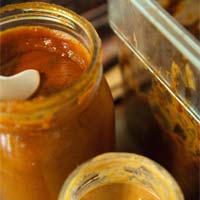

Adapted from BeerAdvocate Magazine: Cuisine à la Bière | Aug 2009 | Issue #31
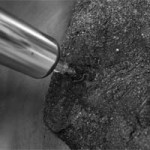
| Servings | Prep Time |
| 8 guest | 15 minute |
| Cook Time | Passive Time |
| 10 - 16 hour | 24 hour |
|
|

|
Injecting a pork butt with IPA, to marinate it from the inside out with the flavors of citrus and hops. This Blind Pig-Injected Smoked Pork Butt is so delicious!
|
- 10 ounce IPA such as Russian River Brewing Co. Blind Pig
-
2 each
garlic, cloves peeled and grated on a Microplane Zester | Grater
- 1 tablespoon Home Brew Chef All Purpose BBQ Rub recipe here
- 5 - 6 pound pork shoulder or Boston butt, bone in
- 1/2 recipe Home Brew Chef All Purpose BBQ Rub recipe here
- 1 recipe IPA Mustard Sauce for BBQ recipe here
- Begin by placing the IPA, garlic and Home Brew Chef All-Purpose BBQ Rub in the pitcher of a blender. Blend until the garlic is smooth to prevent the needle of the Bayou Classic Injector
from clogging. Fill the syringe with the marinade. Take the pork butt and rinse under cold water. Pat dry with paper towels. Place the butt into a large casserole pan. Begin mapping out the bone. Starting on the opposite side of the bone, inject the meat with the marinade by plunging the needle into the flesh, then pull the needle to the surface of the meat (using the same hole) and inject the needle at a different angle. Repeat this technique, using the same hole at four different angles. Repeat this process throughout the butt until all the marinade is used.
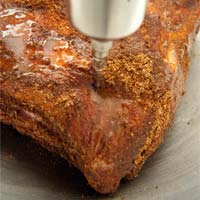
- Now sprinkle the rub on the outside of the meat and coat evenly. Rub lightly, so as not to push the marinade out of the pork. Wrap the pork butt in plastic wrap and refrigerate for 24 hours before smoking, to allow the IPA to marinate the meat while the spice rub cures and flavors the meat. This will yield the best results and set your everyday pulled pork from this one.
- Remove the swine from the refrigerator at least two hours before placing it to the smoker, allowing the meat to come to room temperature.
- If you have a wood-fired smoker, start two pounds of charcoal in the coal box. In a medium-sized bowl, add 3/4 a pound of wood chips or chunks, and top with enough water to cover them, letting soak for 30–45 minutes. Place a water (or beer) pan under the grill rack. This will help maintain a moist environment, making for a juicy barbecue. The coals are ready when they start to show a light layer of white ash on the surface. Add the prepared meat above the water pan. Adjust your air intake and amount of coals to keep the temperature between 225°F | 107°C and 275°F | 135°C, depending on what is being cooked. Check the coals, adding more charcoal and soaked chips/chunks periodically (usually every 45 minutes to an hour) until the meat is done.
- Place the butt into a smoker and smoke at 250°F | 121°C for 10 – 16 hours. Use mesquite for the base heat and add fruitwood chips that have been soaked in either water or beer to the smoker. The internal temperature of the leg should not go beyond 205°F | 96°C. Once done, remove from the smoker and let the butt rest for 30 minutes, covered with aluminum foil. Put on some clean rubber gloves and pull the meat apart. If the crust (or “bark”) is too crispy to pull apart, use a knife to cut it into smaller pieces and then mix it back into the other meat to distribute the flavor. Serve and enjoy!
- This pulled pork can be served as is, or you can add a few different Beer BBQ sauce: IPA Mustard Sauce into the pulled meat for more of a North Carolina-style barbecue.
- Another option is to add some of the Smoked Porter & Tomato Barbecue Sauce for more of a Kansas City spin. Place on a plate or a bun, and enjoy.
More BBQ Recipes:
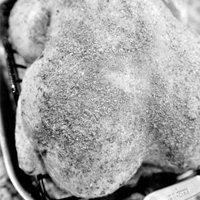
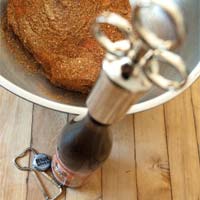


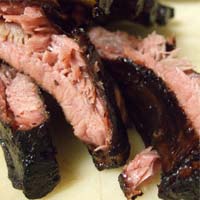


Beer BBQ Sauce Recipes:





Spice Rub Recipes:


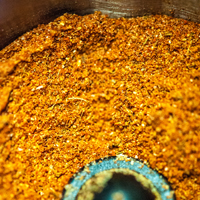
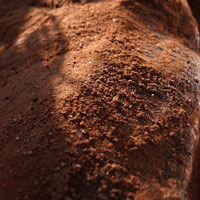

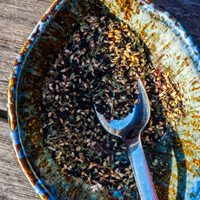
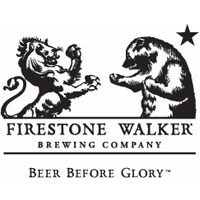
Side Dishes Cooked with Beer:


